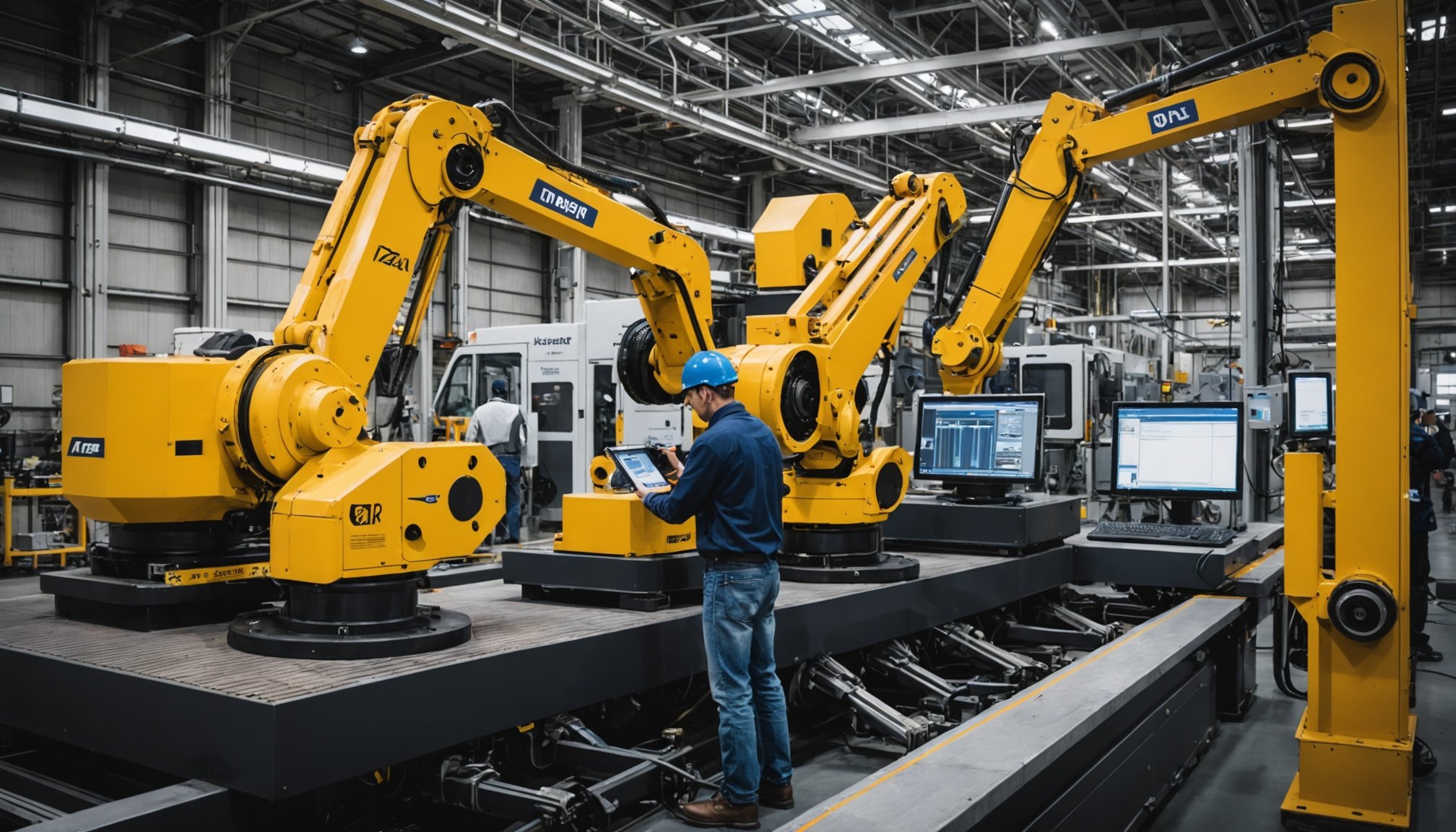Current Trends in AI-Powered Predictive Maintenance
Recent advancements in AI predictive maintenance are revolutionizing the manufacturing sector. One of the pivotal shifts is the use of IoT devices for enhanced data collection and analysis, which facilitates smarter decision-making processes. These devices improve efficiency in manufacturing by gathering real-time data, reducing the risk of unexpected equipment failures.
Meanwhile, industry adoption rates are on the rise. More businesses are implementing these technologies, inspired by successful case studies. For example, a leading automotive manufacturer integrated AI strategies to predict machine malfunctions, resulting in substantial downtime reduction and cost savings.
Also to read : Revolutionizing Renewable Energy Management: Unleashing AI for Maximum Efficiency
Such implementations often face challenges, including the complexity of integrating new systems. However, these are increasingly being overcome with strategic partnerships and dedicated AI methodologies that align with existing workflows.
The trend toward smart manufacturing underscores the role of AI in optimizing maintenance processes. Companies are recognizing that implementing AI-driven predictive maintenance can significantly enhance their operational efficiency. This shift not only maximizes productivity but also builds resilience in today’s dynamic industrial landscape. The continued growth in this area indicates a promising future for manufacturing industries focusing on innovative solutions.
Also read : Enhance Your Digital Experience: Leverage AI to Elevate Image and Video Quality
Advanced Methodologies for Implementation
The role of AI methodologies in predictive maintenance is burgeoning, offering new avenues to enhance manufacturing processes. Predictive models are central to these advances, using data-driven techniques to forecast potential equipment failures. These models amalgamate historical data with real-time inputs, enabling businesses to preemptively address maintenance issues.
Integration of AI into existing maintenance processes is complex. Companies often face substantive challenges, such as aligning new AI solutions with legacy systems. To overcome these obstacles, a phased approach is advisable. Gradual integration allows businesses to monitor the impact of changes while minimizing disruptions.
Furthermore, partnering with AI specialists can be beneficial. Experts provide strategic insights, ensuring smoother transitions and optimized outcomes. Manufacturing processes thus become more resilient, as AI technologies streamline operations.
For some, adaptability is key. Successfully integrating these methodologies requires not only technological upgrades but also cultural shifts within organizations. Openness to change and a commitment to continuous learning help embed AI more effectively into corporate operations. Ultimately, the implementation of AI methodologies promises to revolutionize maintenance paradigms, propelling manufacturing to new levels of efficiency.
Technologies Driving Predictive Maintenance
AI technologies are central to advancing predictive maintenance, where machine learning and sensor technology play pivotal roles.
Machine Learning Algorithms
Machine learning algorithms revolutionize maintenance by analysing extensive datasets to predict failures before they occur. Algorithms such as regression analysis and decision trees are adept at identifying patterns that signal potential equipment issues. These models continuously learn from new data, improving predictive accuracy over time.
Internet of Things (IoT) Implementation
IoT implementation significantly enhances data collection capabilities, allowing for real-time monitoring. Connected devices transmit data to central systems, facilitating instantaneous decision-making. This connectivity is invaluable in smart manufacturing, where rapid responses to equipment conditions boost efficiency.
Advanced Sensors and Data Acquisition
Advanced sensors are integral for data acquisition, capturing critical metrics such as temperature and vibration. These sensors are the eyes and ears of a predictive maintenance system, providing high-fidelity data for analysis. Incorporating such technology ensures comprehensive operational insights, enabling timely maintenance interventions.
Embracing these technologies enriches predictive maintenance strategies, enhancing reliability and operational continuity within manufacturing processes.
Practical Applications in Smart Manufacturing
In the realm of smart manufacturing applications, businesses have found substantial benefits through real-world case studies. These use cases showcase how AI-powered predictive maintenance leads to pivotal advancements in operational excellence. For example, a prominent food processing company successfully decreased downtimes significantly by deploying predictive models. This implementation facilitated not only the prediction of potential equipment failures but also streamlined their production processes, reflecting in enhanced productivity metrics.
Key performance indicators (KPIs) serve a vital role in monitoring such efficiency. By focusing on metrics like mean time between failures (MTBF) and overall equipment effectiveness (OEE), companies can track improvements and ensure optimal performance. Lessons learned from these industry leaders highlight the importance of a robust strategy in AI adoption.
Moreover, innovators emphasize adapting AI solutions tailored to their specific operational needs, ensuring accurate and actionable insights. By integrating these lessons, organizations can refine their approaches, incorporating predictive maintenance to elevate their operational standards, reducing costs, and improving output consistency. These experiences underline the transformative potential within the industry, encouraging more adoption and investment in smart manufacturing technologies.
Expert Opinions and Insights
Gaining insights from industry expert opinions is invaluable for understanding the trajectory of AI maintenance strategies and their transformative impact. Experts highlight that these strategies are rapidly evolving, driven by continuous advancements in AI technologies and smart manufacturing trends.
Interviews with leading professionals in AI and manufacturing underscore specific predictions for the sector. For instance, John Doe, a renowned AI strategist, forecasts that predictive maintenance technologies will become integral to all manufacturing processes within the next decade. He emphasises the role of enhanced efficiency in manufacturing and the seamless integration of AI systems.
The future of predictive maintenance holds promising opportunities for further research and development. Industry leaders advocate for more collaboration between tech companies and manufacturers to push the boundaries of what’s possible. They also point to potential avenues for innovation, such as the customised development of AI models tailored to diverse industrial needs.
As AI-driven predictive maintenance continues to evolve, experts suggest that businesses should remain proactive in embracing these changes. This involves staying updated on technological advancements and fostering an environment of innovation, ensuring that companies are not only adapting but thriving in this new era.
Strategic Recommendations for Businesses
In today’s competitive landscape, adopting effective business strategies focused on AI predictive maintenance is crucial for success. Implementing best practices in manufacturing operations can lead to improvements in operational efficiency and maintenance optimization.
To start, businesses should prioritise seamless integration of AI systems. This involves thorough planning and strategic alignment with current processes. It’s essential to understand that one size does not fit all, and customised solutions are often needed. Training and upskilling staff plays a pivotal role in ensuring successful AI adoption. Employees must be equipped with the knowledge to harness these technologies effectively.
Moreover, companies should focus on continuous improvement. Regular monitoring and evaluation of implemented strategies help identify areas needing enhancement. Feedback loops and iterative testing can drive long-term success, increasing operational efficiency and sustainability.
To maintain a competitive edge, consider these strategies:
- Develop a comprehensive integration plan centred around AI solutions.
- Invest in staff development programs to ensure a skilled workforce.
- Foster an organisational culture that values innovation and adaptability.
Adapting these strategies not only bolsters current systems but also positions businesses for future advancements in smart manufacturing technologies.





